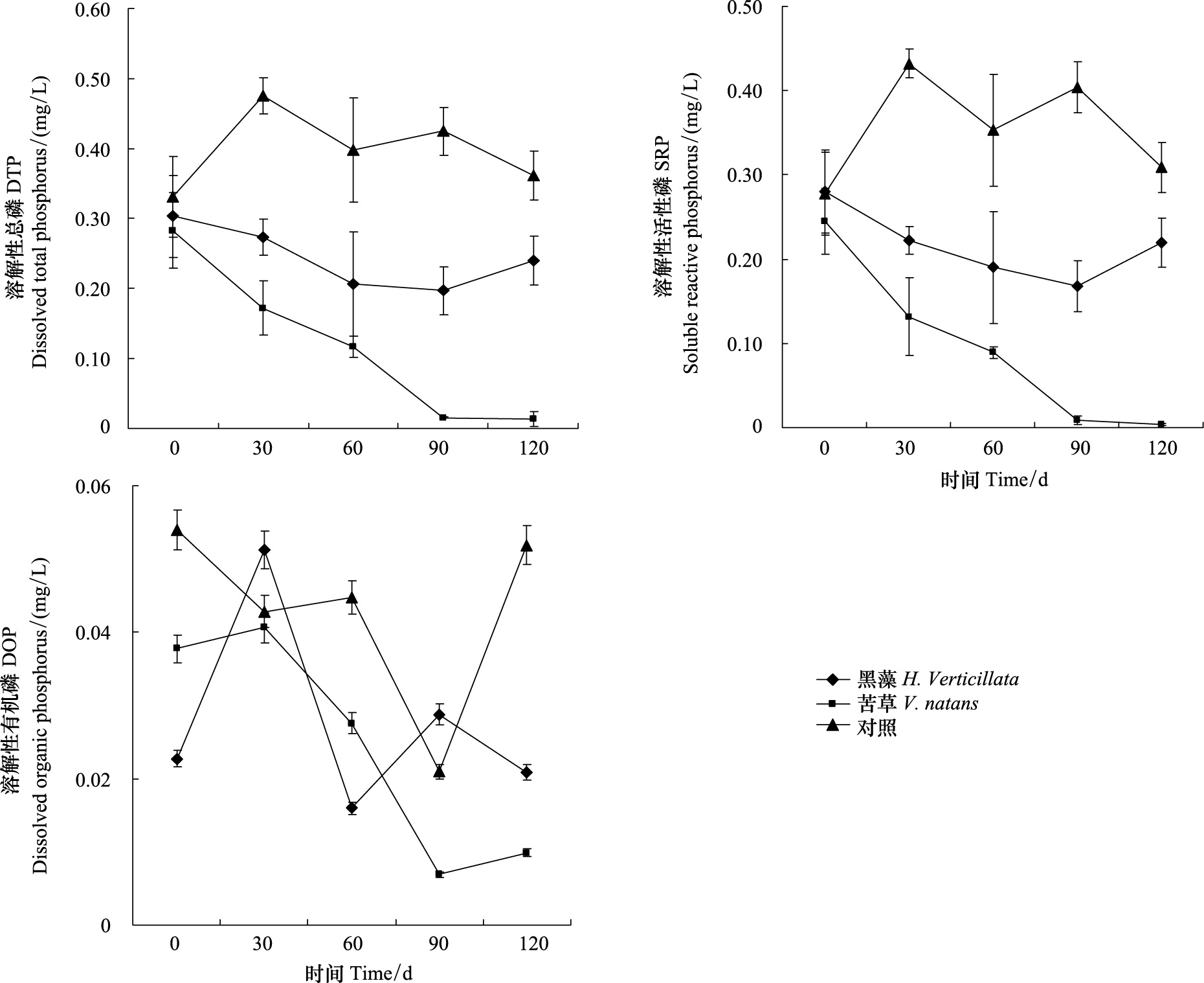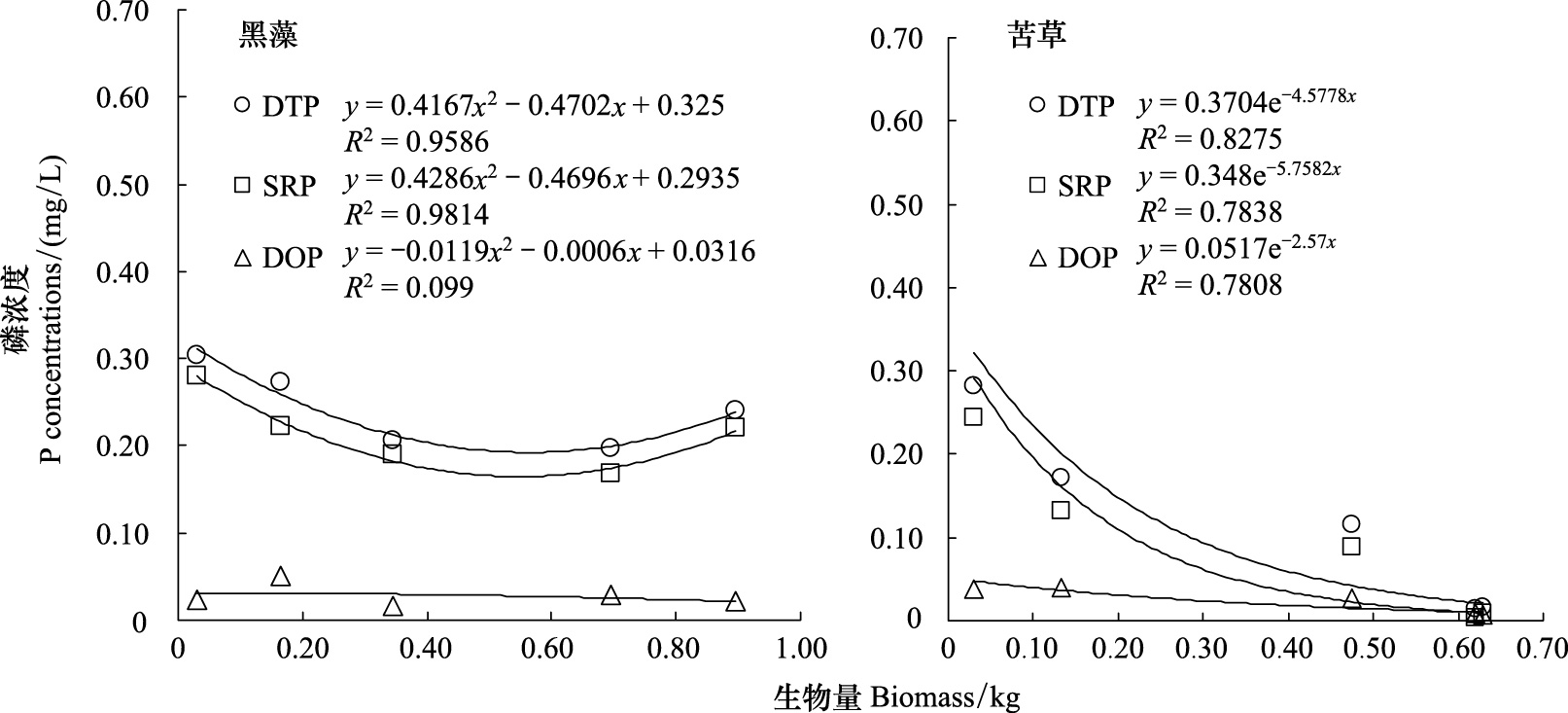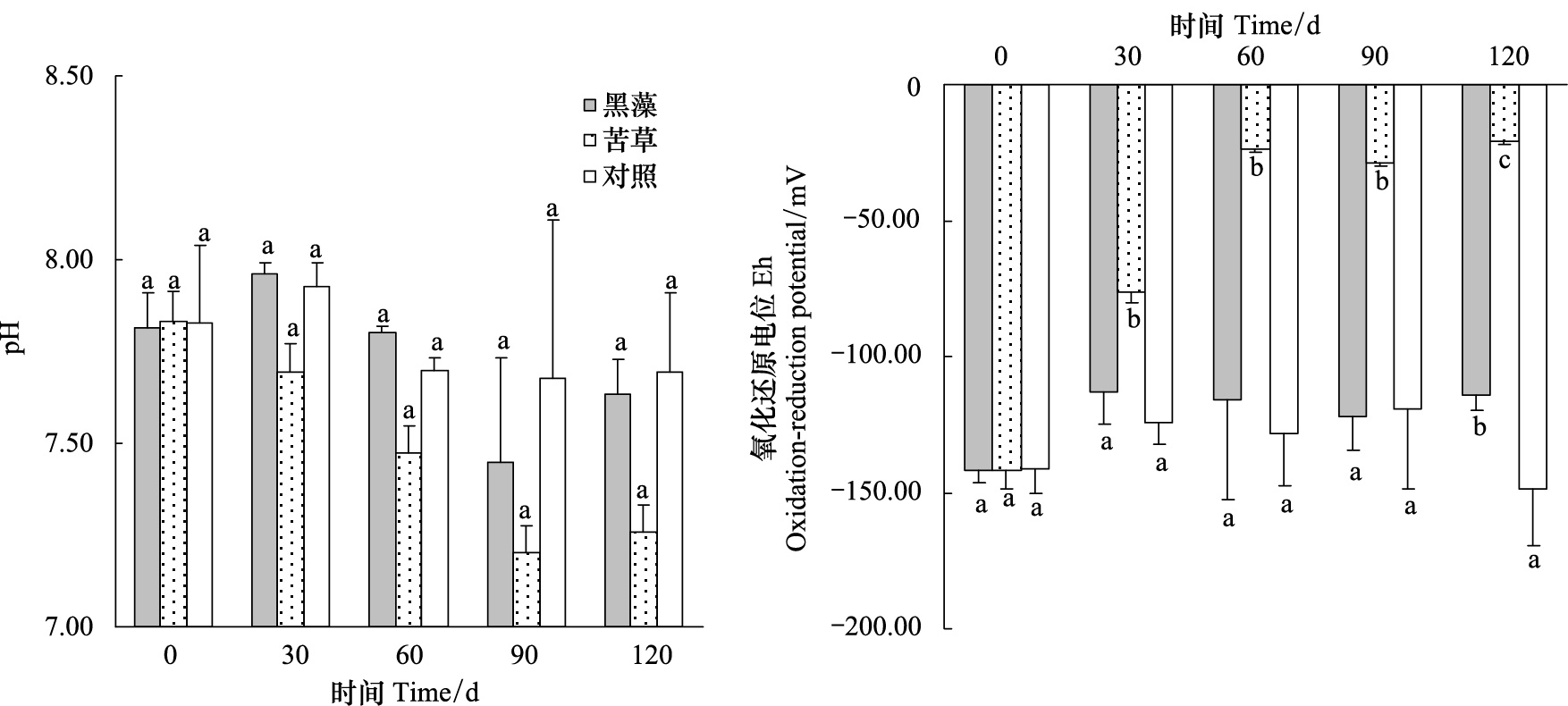文章信息
- 王立志
- WANG Lizhi
- 两种沉水植物对间隙水磷浓度的影响
- Influence of two submerged macrophytes on pore water phosphorus concentration
- 生态学报, 2015, 35(4): 1051-1058
- Acta Ecologica Sinica, 2015, 35(4): 1051-1058
- http://dx.doi.org/10.5846/stxb201305010879
-
文章历史
- 收稿日期:2013-05-01
- 网络出版日期:2014-04-11
沉水植物占据着浅水水体生态系统的关键界面,以自身的形态特征、群落结构特征及生理活动影响着其周围的环境,对水体磷循环具有十分重要的影响[1]。近百年来,湖泊富营养化现象在世界范围内普遍发生,而磷是湖泊富营养化的重要控制因子[2]。大量研究和实践表明,治理浅水湖泊,仅依靠削减外源负荷的措施,经常未能取得预期的降低湖水磷浓度的效果[3, 4],外源消减后,沉积物中的营养盐将释放出来,抵消外源负荷的消减,沉积物对湖泊生态环境的影响与其间隙水密切相关[5],间隙水中氮、磷的含量直接影响沉积物与上覆水之间氮和磷的交换,间隙水中可溶态营养物质氮、磷穿过水-泥界面向上覆水传送是沉积物中营养盐释放的重要途径[6, 7]。沉水植物生长过程中通过根系和茎叶吸收间隙水和水中的营养物质,从而影响氮磷等营养盐的循环过程,因此开展不同沉水植物对间隙水磷的影响显得尤为重要,鉴于此,本研究通过选取根系较少的沉水植物黑藻和根系相对较发达的沉水植物苦草作为实验材料,研究两种沉水植物在生长过程中对间隙水中磷的影响,为湖泊富营养化治理提供理论依据。
1 实验材料与设计 1.1 材料与设计底质采自富营养化水华爆发水体,采集后样品低温风干后过100目筛,去除粗粒及动植物残体,然后充分混匀。将混匀后的底质加入高密度聚乙烯桶(顶直径×底直径×高=55 cm×45 cm×75 cm,预先经过5% 的HCl处理后用蒸馏水冲洗干净),底质平均厚度为10 cm,底质干重为4821.00 g。然后缓慢注入蒸馏水100 L。
按照植物的顶冠特征和根系状况的不同,分别选取根系较少沉水植物黑藻和根系相对较发达的沉水植物苦草作为实验植物,以说明沉水植物生长期不同根系特征对底泥间隙水磷浓度的影响。
实验设置实验桶装置总计9桶,其中沉水植物苦草(30 g 鲜重)和黑藻(30 g鲜重)休眠芽分别种植3桶,另外3桶不种植沉水植物作为对照组。沉水植物黑藻和苦草采用性状均一的休眠芽,均匀种植于实验桶。实验时间为2012年5—9月。
实验在温室玻璃房内进行,实验温室内部月平均光照及温度变化情况如图 1所示。

|
| 图 1 实验温室内部月平均光照及温度 Fig. 1 The average temperature and illumination of the experiment glass room |
实验期间水温按照室外的温度控制在5—25 ℃,各桶间水温差异小于2 ℃。将底质均匀铺设于实验桶底后,缓慢注入蒸馏水,待实验装置稳定10 d后,均匀种植沉水植物,并采集水样进行测定,同时采用探头测定底质物理指标,上覆水及底泥初始理化指标如表 1所示。由于底质中氮磷等营养物质在稳定期间存在向水中的释放过程,因此,水中氮磷的含量分别为1.25和0.05 mg/L。
| 样品 Sample | 项目 Items | 单位 Unit | 黑藻 H. Verticillata | 苦草 V. natans | 对照 Control |
| TP: 总磷Total phosphorus,DTP: 溶解性总磷Dissolved total phosphorus,SRP: 溶解性活性磷Soluble reactive phosphorus,PP: 颗粒磷Particle phosphorus,TN: 总氮Total nitrogen,NH+4-N: 氨氮 Ammonium nitrogen,NO-3-N: 硝态氮Nitrate nitrogen,DO: 溶解氧Dissolved oxygen,Eh:氧化还原电位 Oxidation-reduction potential | |||||
| 水 | TP | mg/L | 0.05 | 0.05 | 0.05 |
| Water | DTP | mg/L | 0.03 | 0.03 | 0.02 |
| SRP | mg/L | 0.01 | 0 | 0.01 | |
| PP | mg/L | 0 | 0.01 | 0.01 | |
| DOP | mg/L | 0.01 | 0.01 | 0.01 | |
| TN | mg/L | 1.25 | 1.25 | 1.25 | |
| NH+4-N | mg/L | 0.21 | 0.21 | 0.21 | |
| NO-3-N | mg/L | 0.12 | 0.12 | 0.12 | |
| pH | 7.5 | 7.6 | 7.5 | ||
| DO | mg/L | 8.11 | 8.1 | 8.01 | |
| Eh | mV | 176.33 | 170.22 | 173.14 | |
| 底泥 | TP | mg/kg | 736.25 | 704.58 | 744.17 |
| Sediment | TN | mg/kg | 1864.36 | 1864.36 | 1864.36 |
| pH | 7.81 | 7.83 | 7.83 | ||
| Eh | mV | -141.92 | -141.53 | -141.57 | |
水样采集采用虹吸管抽取的方式,采集水面以下5 cm、20 cm和45 cm处的等体积水(50 mL)混匀。底泥采用微型柱状采泥器采集,底泥样品每次均匀采集5个微型柱状样(横切面直径2 cm),采集后的样品室温(25 ℃)风干,然后对风干前后的样品称重以计算由采样带来的总体磷和水量的损耗。将风干后底泥样品与植物根系分离,过100目筛后充分混匀,然后进行底泥中各形态磷分析。间隙水采用自行研制的原位渗滤器进行采集,将原位渗滤器在实验种植植物之前埋置均匀与底泥中,在需要采集时打开渗滤器进行间隙水渗滤,并收集间隙水,用0.45μ的醋酸纤维素滤膜过滤采集到的间隙水,采用钼锑抗比色法直接测定磷含量得到SRP的浓度,将滤液采用过硫酸钾消解法测定磷的含量得到DTP的浓度,DOP浓度为DTP和SRP之差。底泥样品磷分析采用国际通用的SMT法[8]。上覆水中磷浓度按照钼锑抗比色法分析。所有样品分析采用意大利连续流动分析仪FLOWSYS III 完成。
1.3 生物量统计另外选取不同生长期沉水植物,统计黑藻不同生长阶段的株高(X1 /cm)和生物量(鲜重,W/g),生物量统计采用整株挖出的方法,将植物根系的底泥小心冲洗干净后,采用吸水纸吸收植物表面残留水分,吸干后进行称量。苦草统计叶片长度(X1 /cm)、叶片宽度(X2 /cm)和生物量(W/g),苦草生物量的测定方法与黑藻一致。建立不同植物的生物量模型,以推算沉水植物在生长过程中的生物量。
不同沉水植物生长期的生物量模型为:
W黑藻 =0.0198X1+0.5479 R2=0.86 P<0.05
W苦草=0.0230X1+0.2029 X2-0.2576 R2=0.76 P<0.05
1.4 数据处理实验所得数据采用SPSS16.0统计软件进行方差分析,处理组和对照组之间采用单因素方差分析法,P<0.05为差异性显著,P<0.01为差异性极显著。
2 实验结果 2.1 间隙水形态磷含量的变化实验期间黑藻和苦草组间隙水中各形态磷的浓度均呈不同程度的降低。DTP和SRP的浓度在实验期间总体呈下降趋势,在实验第120天黑藻组间隙水中DTP和SRP的浓度均呈上升趋势,浓度分别为0.24和0.22 mg/L(图 2)。方差分析表明实验期间黑藻组间隙水中DTP和SRP的浓度显著低于对照组(P<0.05)。黑藻组间隙水中DOP在整个实验期间呈下降趋势,但是方差分析表明黑藻组和对照组之间DOP浓度无显著差异(P>0.05)。

|
| 图 2 实验期间间隙水中各形态磷的含量 Fig. 2 Phosphorus concentrations in pore water during the experiment course |
苦草组间隙水中DTP和SRP的浓度在实验0至120天均呈下降趋势,在实验第120天达到最低值分别是0.01和0.004 mg/L(图 2)。方差分析表明实验期间苦草组间隙水中DTP和SRP的浓度显著低于对照组(P<0.05)。苦草组间隙水中DOP在整个实验期间呈下降趋势,但是方差分析表明苦草组和对照组之间DOP浓度无显著差异(P>0.05)。
黑藻、苦草和对照组间隙水中DTP、SRP和DOP的浓度大小表明,间隙水中磷的形态主要以DTP和SRP为主,DOP的含量相对较低。
2.2 底泥及水中磷含量的变化实验结果表明沉水植物组底泥中各形态磷的含量均呈现不同程度的降低,其中苦草组各形态磷含量降低幅度均较大。黑藻和苦草底泥TP的含量最大降低幅度分别为35.34、60.67 mg/kg(图 3)。

|
| 图 3 实验期间底泥和水中磷含量变化(不同字符标准表示差异性显著(P < 0.05)) Fig. 3 Phosphorus concentrations in water and sediment during the experiment course,different letters above bars indicate a significant difference between treatments(P<0.05) |
苦草组水中磷的浓度在实验期间保持在相对较低的水平(0.04—0.10 mg/L)。从对照组水中磷含量呈先升高后下降的趋势中可以看出实验组水中磷浓度的上升与底泥中较高的磷含量有关,在实验开始时配水中磷含量较低,导致了底泥向水体中磷的释放,从而使得水体中磷的含量呈偏升高趋势。黑藻组水体中磷浓度总体保持在相对较稳定的水平,磷浓度在0.03—0.05 mg/L之间波动。
3 讨论 3.1 沉水植物生长对间隙水磷浓度的影响在实验中实验第30 天后黑藻和苦草进入旺盛生长期(图 4)。沉水植物在旺盛生长期对营养盐的需求量大,沉水植物在生长、繁殖过程中,吸收水体及底泥中氮、磷等营养物质,其中底质吸收是植物组织矿质营养的主要来源[9]。沉水植物可以直接从水体或底泥中吸收 N、P,然后分配到枝条。实验结束时,采集沉水植物植物样本进行植物体内磷含量分析(将烘干后植物进行粉碎,分析样品为植物茎叶和根系的混合样),然后将植物干重乘植物体内的磷含量,获得植物富集的磷总磷,试验结束时黑藻和苦草分别聚集的磷总量为,159.07和249.06 mg。在本实验系统中,处于一个相对封闭的环境,没有外源磷的输入,因此沉水植物体内富集的磷只来自于水和底泥。这是沉水植物降低上覆水和间隙水中磷的浓度的一个重要原因[10]。从本实验结果看根系发达的沉水植物苦草对间隙水中磷的吸收能力要大于黑藻,同时,沉水植物对间隙水磷的吸收主要作用于DTP和SRP。

|
| 图 4 实验期间每实验桶植物生物量变化 Fig. 4 Biomass changes in the experiment bucket |
沉水植物的生长对间隙水中磷的浓度具有重要的影响[11],因此,将实验桶中生物量和间隙水中各形态磷含量进行函数拟合,可以反映沉水植物生长过程对间隙水中磷的影响。黑藻生物量和间隙水中各形态磷的函数拟合表明,生物量的变化和间隙水中DTP和SRP的变化呈显著相关,与DOP含量的变化呈若相关(图 5)。DTP和SRP随着的生物量的变化呈先降低后升高的抛物线趋势变化,说明黑藻在快速生长期能快速降低间隙水中DTP和SRP的含量,但是,当黑藻生物量达到稳定阶段时间隙水中DTP和SRP的含量有一定的反弹,呈上升趋势。函数模拟推算当生物量达到0.5614和0.5478 kg时间隙水中DTP和SRP的含量分别达到最低值。

|
| 图 5 实验组生物量和间隙水磷含量之间函数模拟 Fig. 5 Function simulation between biomass and phosphorus concentrations in pore water DTP: 溶解性总磷; SRP: 溶解性活性磷; DOP: 溶解性有机磷 |
苦草生物量的变化和间隙水中DTP和SRP的变化呈显著相关,间隙水中各形态磷含量随着生物量呈指数降低(图 5)。在苦草生物量最大时间隙水中各形态磷含量并未出现如黑藻组的反弹现象,这和苦草对底泥间隙水各形态磷较高的吸收效率及对底泥环境的影响有重要关系。较高的吸收效率使得间隙水中各形态磷含量在实验后期均保持在较低的水平,苦草在生长过程中对底泥环境因子的改变同时也抑制了底泥向间隙水中磷的释放过程,因此根系较为发达的沉水植物苦草能使得间隙水中磷含量保持在较低的水平。
3.2 底泥环境因子的变化对间隙水磷浓度的影响影响底泥磷释放的因素很多[12],包括生物的(细菌活动、生物扰动等)、化学的[氧化还原电位(Eh)、pH值、溶解氧(DO)、铁结合态磷含量比等]以及物理的(风浪扰动等)等因素[13]。研究表明,DO、pH值、Eh、温度及水动力条件等是影响底泥中磷的释放与吸收的主要因素[14]。
在本实验条件下,由于是室内培养实验,对温度和水动力均做了限制,因此底泥中环境因子pH值和Eh的变化是影响底泥磷释放的主要因子。
植物在生长过程中可以通过自身的光合、呼吸作用将氧通过茎叶带入到根系,并在根系周围形成氧化区域,氧浓度大小对底泥磷释放有重要影响。当水-底泥界面控制在好氧状态时,底泥的磷释放量小于厌氧状态下的释放量[12]。溶解氧充足情况下,底泥表层Eh较高,利于Fe2+转化为Fe3+,Fe3+与磷酸盐结合成难溶的磷酸铁,使好氧状态下底泥对磷的释放作用减弱。厌氧时,Fe3+还原成Fe2+,一方面使PO3-4脱离原来沉淀状态进入水中,另一方面(Fe(OH)3)x胶体转化成可溶的Fe(OH)2,同时释放吸附于其上的游离态磷,导致水中溶解态磷浓度增加[15]。因此,较高的Eh能降低水中磷含量。
pH值是水质的重要指标,它对水体物理化学反应有重要影响。碱性条件下,pH值升高时底泥磷释放增加;在中性范围内,释磷量最小;酸性条件下促使磷的释放。温度对水体磷的循环也会产生一定的影响。研究表明[7],随温度的升高,底泥磷释放增加。
在本实验中,黑藻和苦草组底泥pH值在实验期间均低于对照组,且苦草组底泥pH值的降低幅度要大于黑藻组,因此黑藻和苦草均能降低沉积物的pH值,但是各植物组pH值的变化范围在7—8之间(图 6),因此,沉积物pH值保持在中性范围之内,底泥磷释放量最小。
苦草组沉积物Eh在实验第30天就显著低于黑藻组和对照组(P<0.05),并在后期实验中呈上升趋势(图 6),所以,苦草组沉积物中较高的Eh抑制了底泥磷的释放是间隙水中磷浓度较低另外一个重要原因。黑藻组底泥Eh较对照组虽然有升高趋势,但在实验大部分时间均无显著差异(P>0.05),因此,黑藻底泥中较低的Eh导致了底泥中磷的释放,是间隙水中磷浓度相对偏高的另外一个重要原因。

|
| 图 6 实验期间环境因子的变化(不同字符标准表示差异性显著P < 0.05) Fig. 6 Environmental factor changes in the experiment,different letters above bars indicate a significant difference between treatments (P < 0.05) |
沉水植物黑藻和苦草对于稳定水质,减少底泥中的磷向水体转移有明显的效果,沉水植物不同,底泥间隙水中DTP和SRP存在明显差异。沉水植物黑藻和苦草在生长期均能降低间隙水中磷的浓度,苦草对间隙水中DTP和SRP的降低能力要大于黑藻,实验第120天黑藻和苦草组间隙水中DTP和SRP的含量均显著降低,黑藻和苦草对DOP具有一定的降低作用,但和对照组相比无显著差异。
沉水植物黑藻和苦草在生长期均能降低底泥中磷的含量,并降低底泥pH值,提高底泥Eh,苦草对底泥Eh的提高能力要大于黑藻。
| [1] | Søndergaard M, Phillips G, Hellsten S, Kolada A, Ecke F, Mäemets H, Mjelde M, Azzella M M, Oggioni l. Maximum growing depth of submerged macrophytes in European lakes. Hydrobiologia, 2013, 704(1): 165-177. |
| [2] | Wang S G, Jin X C, Pang Y, Zhao H C, Zhou X N, Wu F C. Phosphorus fractions and phosphate sorption characteristics in relation to the sediment compositions of shallow lakes in the middle and lower reaches of Yangtze River region, China. Journal of Colloid and Interface Science, 2005, 289(2): 339-346. |
| [3] | Van Nes E H, Scheffer M, van den Berg M S, Coops H. Charisma: a spatial explicit simulation model of submerged macrophytes. Ecological Modelling, 2003, 159(2/3): 103-116. |
| [4] | Ye C, Yu H C, Kong H N, Song X F, Zou G Y, Xu Q J, Liu J. Community collocation of four submerged macrophytes on two kinds of sediments in Lake Taihu, China. Ecological Engineering, 2009, 35(11): 1656-1663. |
| [5] | Wang F, Liang L L, Zhang Y S, Gao R H. Eco-hydrological model and critical conditions of hydrology of the wetland of Erdos Larus Relictus Nature Reserve. Acta Ecologica Sinica, 2009, 29(5): 307-313. |
| [6] | Sun S J, Huang S L, Sun X M, Wen W. Phosphorus fractions and its release in the sediments of Haihe River, China. Journal of Environmental Sciences. 2009, 21(3): 291-295. |
| [7] | Haygarth P M, Condron L M, Heathwaite A L, Turner B L, Harris G P. The phosphorus transfer continuum: Linking source to impact with an interdisciplinary and multi-scaled approach. Science of the total environment. 2005, 344(1/3): 5-14. |
| [8] | Ruban V, López-Sánchez J F, Pardo P, Rauret G, Muntau H, Quevauviller P. Harmonized protocol and certified reference material for the determination of extractable contents of phosphorus in freshwater sediments -A synthesis of recent works. Fresenius Journal of Analytical Chemistry, 2001, 370(2/3): 224-228. |
| [9] | Schorer A, Schneider S, Melzer A. The importance of submerged macrophytes as indicators for the nutrient concentration in a small stream (Rotbach, Bavaria). Limnologica - Ecology and Management of Inland Waters, 2000, 30(4): 351-358. |
| [10] | Horppila J, Nurminen L. Effects of submerged macrophytes on sediment resuspension and internal phosphorus loading in Lake Hiidenvesi (southern Finland). Water Research, 2003, 37(18): 4468-4474. |
| [11] | Sorrell B K, Downes M T, Stanger C L. Methanotrophic bacteria and their activity on submerged aquatic macrophytes. Aquatic Botany, 2002, 72(2): 107-119. |
| [12] | Wang S R, Jin X C, Bu Q Y, Jiao L X, Wu F C. Effects of dissolved oxygen supply level on phosphorus release from lake sediments. Colloids and Surfaces A: Physicochemical and Engineering Aspects, 2008, 316(1/3): 245-252. |
| [13] | Asaeda T, Trung V K, Manatunge J. Modeling the effects of macrophyte growth and decomposition on the nutrient budget in Shallow Lakes. Aquatic Botany, 2000, 68(3): 217-237. |
| [14] | Jin X C, Wang S R, Pang Y, Wu F C. Phosphorus fractions and the effect of pH on the phosphorus release of the sediments from different trophic areas in Taihu Lake, China. Environmental Pollution, 2006, 139(2): 288-295. |
| [15] | Wang S R, Jin X C, Zhao H C, Wu F C. Phosphorus fractions and its release in the sediments from the shallow lakes in the middle and lower reaches of Yangtze River area in China. Colloids and Surfaces A: Physicochemical and Engineering Aspects, 2006, 273(1/3): 109-116. |
 2015, Vol. 35
2015, Vol. 35




